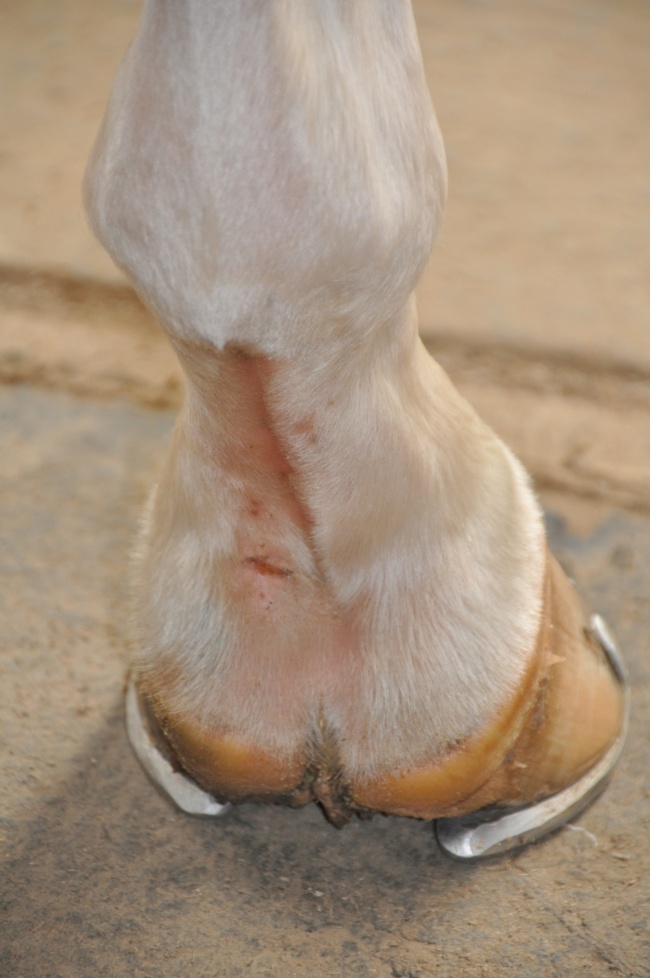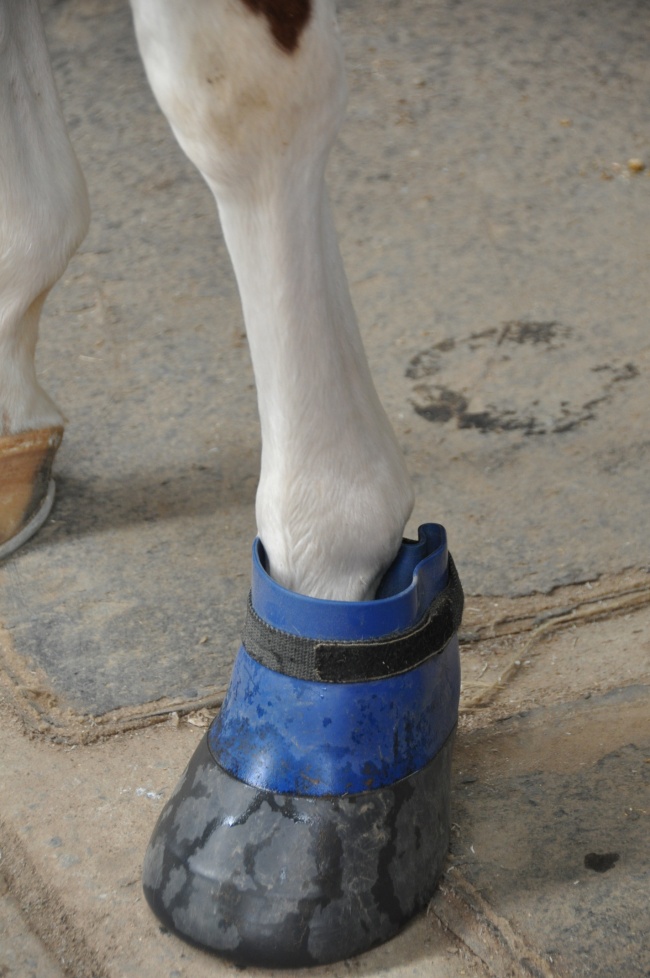First posted- April 21, 2014
*The following suggestions are treatments for minor injuries. If you have any concern consult the farm manager and/or your veterinarian.***
BASIC CUTS & SCRAPES:
Basic cuts and scraps can be treated with Corona. It keeps the area moist and prevents scabbing. If the area looks irritated use a triple antibiotic ointment from your local pharmacy. If the cut is deep, your horse may require stitches- a good time to call your vet.
FUNGUS Treatment:
I like to liberally apply Calm Coat or mineral oil on the affected area prior to riding, allowing the oil to soak in for about an hour and then with mild soap, gently wash the oil off. This will greatly help reduce the scabs with minimal irritation during the process. Don’t scrub and make them bleed, this can cause scaring and their hair to grow back white. You might need to do this a multiple of times depending on the severity of the fungus. To head off potential fungus; if your horse was rained on and comes in with small raised bumps, after using a gentle soap (anti-fungal or not) sponge on a mixture of white vinegar and water- about two cups of vinegar to two gallons of water on their entire body and leave- don’t rinse. The base nature of the vinegar will help neutralize the acidity of the rain. If they come in with lots of bumps, or giant bumps, this might indicate a more severe allergic reaction which might need the help of your vet to clear up. A steroid- Dexamethasone should help soothe and clear up the bumps. Antibiotics as well as immune stimulants such as oral SMZ’s and oral levamisole paste will help clear oozing fungus that goes beyond basic fungus.
SCRATCHES Treatment:
Scabs appearing below the fetlock are called scratches. This can be very painful as the irritation causes cracks in their skin where there is high mobility, causing them to be lame. Clean with mild soap and apply a mixture of triple antibiotic ointment and Desitin. The antibiotic helps fix the issue while the desitin keeps the area dryer. Ideally keep them out of mud, or other irritating footing. Make sure that their legs are dry prior to putting them back in their stall since the bedding can stick to their legs and stifle air circulation- which leads to worsening the problem. If basic cleanliness and being diligent about drying their legs still doesn’t fix the scratches within 10 days- try a mixture of triple antibiotic and hydrocortisone. I have had a few thin skinned Chestnut Thoroughbreds that this really helped.
PUNCTURES:
Puncture wounds usually cause the leg/area to swell and be warm/hot. Keep the area clean and pull the scab off to allow for drainage. Simple punctures will require oral antibiotics and Gentocin administered in the puncture hole. If you aren’t sure about the depth or severity of the puncture, get your vet out to check and recommend treatment.
SOFT TISSUE IRRITATION OR DAMAGE:
If the leg is swollen with no puncture or apparent irritation you are most likely looking at soft tissue irritation or damage. Ice or cold hose the leg, apply poultice, and a standing wrap. Keep your horse stalled and alert your vet. More than likely you will need to have your horse ultra-sounded to see the severity of the injury, however ideally the swelling should be minimal to view the scan properly. Your vet might recommend pheno-butazolidin- otherwise known as bute administered orally or IV injection for a few days prior to his/her arrival. At best, your horse has simply strained a tendon or ligament and will be back to full work within a short time. At worst, you will need to stall rest, continuing to ice and wrap and when deemed appropriate by your vet, start the slow process of slowly bringing them back. Since tendons and ligaments whole job is to stretch- keeping them moving so that it heals with the maximum amount of stretching is ideal. The key however is to stretch while healing, and not further tear… your vet will help you with the tedious rehab plan. Where the injury has taken place, as well as the severity of the injury can dictate other options such as Stem cell therapy, Platelet-Rich- Plasma (PRP) Therapy, as well as ARP Therapy, all options that help create new stronger scaffolding within the tear of the soft tissue that will in turn heal quicker and stronger.
CHECK SHOES:
Your horse’s hooves are very important. It is a small surface area supporting a lot of weight. If your horse has shoes make sure they are on tight and straight. Do not ride if there is any question. If the shoe is twisted or bent, remove it so they don’t torque any soft tissue being off balance, or step on nails or clips.
MISSING SHOES:
When your horse is missing a shoe or has soft soles you should apply sole paint (it helps promote circulation and strengthens the sole which has been compromised) Wrap the hoof in a diaper to prevent further bruising and for good measure apply a layer of duct tape to the bottom to keep it from wearing off in their stall. Make sure that you don’t bind their heel bulbs or their coronet band with the duct tape as this tape doesn’t breathe. The diaper/duct tape wrap will need to be replaced daily and your horse will probably need to be kept in their stall until the farrier can replace the missing shoe.
FOOT ABSCESS:
If your horse comes up acutely lame, and is non-weight bearing, I would suspect an abscess, since there is no where for a swelling in the hoof to go which makes it incredibly painful. However, contact your vet and or farrier to be sure, since this also could be a sign of something far more serious. Squeezing the sole and around the shoe/nails with a hoof tester might indicate the source of pain however your farrier might need to remove the shoe completely to check further. Close nails- which could have been properly driven in but with sloppy footing and/or a weak/compromised hoof wall, shifted and can create abscess tracts . If the hoof is bruised or you suspect an abscess you should soak the foot in Epsom salt and warm water. They make a handy soaking boot which facilitates this procedure (easier to strap the boot on then trying to keep your horse’s foot in a big bucket) Follow with Epsom salt paste on the sole and again wrap in a diaper, and duct tape. This procedure ensure that the tract doesn’t close back up and start the abscess all over again. Typically an abscess will not require antibiotics since it is isolated, and once opened and drained will start healing quickly. The administration of a pain killer (bute) can be administered to promote further walking which will drive the infection out. While treating an abscess, it is important that your horse not be turned out in muddy footing which can clog up the tract if the diaper wrap falls off. A sandy small paddock turnout is ideal.
IN CONCLUSION:
When an injury or missing shoe requires your horse to be stall bound make sure you hand walk and graze them. They will also appreciate a good grooming – they can’t roll in their stall very well! It is hard on them to be confined to a stall for 24 hours, so make sure you use a chain lead rope to give you extra control – they may be fresh. We hope that your horse stays injury free at all times but it is almost inevitable that they will have some sort of injury at some point- it goes with the territory since they are big athletes that can be hard on their bodies. Be patient when they have their off time, and appreciate the good times! Happy Riding!


